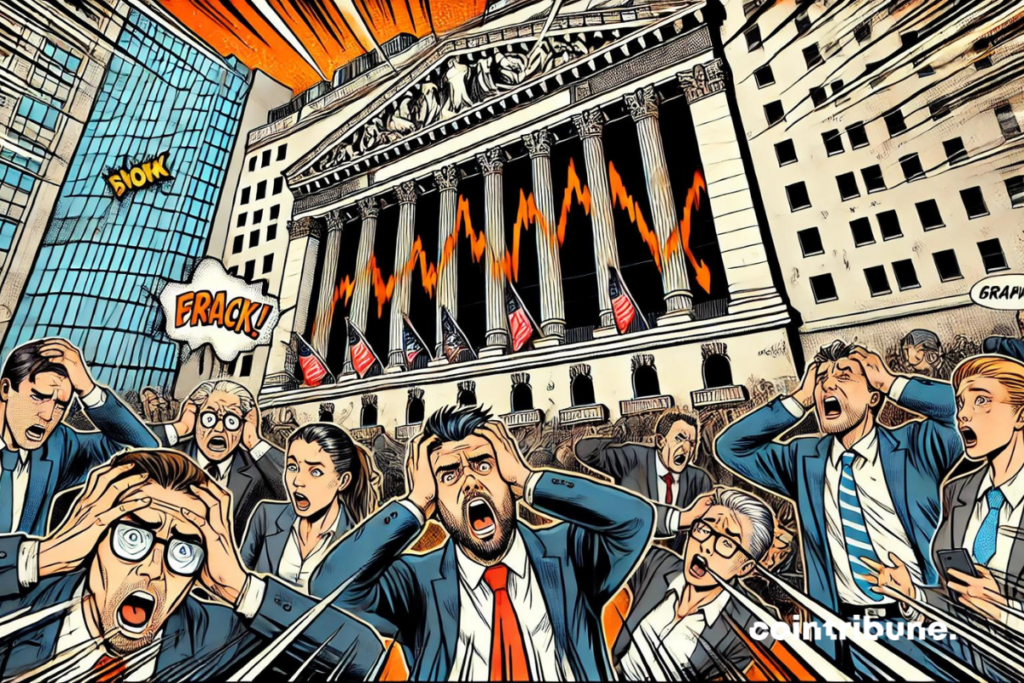Will the Fed Let the Markets Drop by 80%?
0
0
The markets have historically plummeted in recent days. Could we be heading towards a new descent into hell, or will the Fed lower rates and trigger a new stock market boom?

Should we panic?
To what extent should we panic in the face of this decline?
When zooming out, we observe that at present, even after this week’s decline, stocks are still up nearly 10% since the beginning of the year.
And over the past year, even after this week, the market has still risen by 15.5% – an exceptionally good performance!
Why did stocks decline?
We don’t really know.
Stocks don’t really need a reason to decline: U.S. stocks are quite expensive at the moment, from a historical perspective, and investors may simply have been worried about this situation.
On the other hand, the decline was global, which probably doesn’t explain everything.
In Japan, where the price drop was the largest, approaching a true “crash,” the story is quite clear.
Japan and the rate hike
The Bank of Japan raised its interest rates in an attempt to prevent the yen from weakening too much.
Higher rates lower stock prices. In fact, this could have caused at least part of the global decline through a general panic or because overleveraged global investors were forced to sell U.S. and European stocks to repay their loans when the price of their Japanese stocks dropped.
Towards a U.S. recession?
Let’s come to the reason most financial journalists cite for explaining the stock prices drop in the United States. Almost everyone attributes the stock decline to the slowdown of the U.S. economy.
Friday’s U.S. employment report, which revealed a much sharper slowdown in hiring than Wall Street expected, reinforced fears that the world’s largest economy is under increasing strain due to high borrowing costs.
Business leaders reported during the recent earnings season that consumers, who play a central role in the U.S. economy, are beginning to cut back on spending.
High interest rates are supposed to slow down the economy. And when the economy slows, corporate profits also decline, which lowers stock values.
Still low unemployment
Every month, the Bureau of Labor Statistics asks businesses how many people they employ. In recent years, that number has generally increased by at least 200,000 per month. But in July, it increased by only 114,000.
Does this mean that the economy is slowing down? Maybe.
But it’s also true that as an economy reaches full employment, that number has to decrease.
Once everyone has a job, you can’t keep increasing the number of employed people!
The labor market is slightly weaker than it was a year ago, but not much weaker. Labor market tension indicators have decreased, but they are roughly at the same level as before Covid when the economy was strong. The employment rate of working-age people is still high and even increased in July.
So it doesn’t look like a distressed economy.
A still solid economy for the Fed?
Let’s now look at macro indicators.
Consumption is good, GDP growth is good, industrial production has accelerated. Only employment seems a bit weak.
Labor productivity growth is also solid, standing at 2.3% in the quarter ending in June. In fact, labor productivity is increasing almost at the same pace as GDP itself, suggesting that economic growth is sustainable.
In other words, there is a bit of weakness in the labor market, but overall, the economy looks pretty good.
We can therefore be cautious about the idea that weak recession economic data caused the stock decline.
What about the Fed?
The Fed should probably start lowering rates now because the economy seems to be counting on it.
Interest rates influence stocks in two main ways.
First, interest rates are part of the discount rate – higher rates mean that future profits (or cash flows) are worth less today.
Second, it is generally believed that high interest rates reduce overall demand, which slows down the real economy and reduces future profits.
In summary, if interest rates are higher, it’s bad for stocks.
Interest rates aren’t the only thing that matters: the future path of interest rates matters a lot. If it seems like the Fed is about to start a long, steady process of lowering rates, that’s very positive for stocks.
But if it seems like the Fed is just going to keep interest rates at 5.33% for the foreseeable future, that’s much worse for stocks.
Right now, there is a lot of uncertainty about the Fed’s stance.
Is the Fed ready to lower rates?
A slight increase in inflation earlier this year, coupled with the continued strength of the real economy, convinced the Fed not to start lowering rates.
Since April, however, inflation has started to decline again. Annualized inflation, by all standard measures, has been declining after that small upsurge.
And measured month-to-month, inflation is now at or below the 2% target.
The Fed had two ways to react. The first was to say: “This looks good, but let’s wait another six months or a year to make sure post-pandemic inflation is completely gone.”
Another was to say: “Inflation is decreasing, and unemployment is rising, so let’s go ahead and start lowering rates now.”
Markets now expect the Fed to respond to recent slightly weak economic data by lowering rates in September.
Investors are betting that the Federal Reserve will respond to signs of economic weakness with more aggressive rate cuts.
Futures contracts imply a 94.5% probability of a half-point cut at this meeting, compared to 74% on Friday and only 11% a week ago. A week ago, investors only expected a 0.75 percentage point cut this year, or three quarter-point cuts.
Can the Fed maintain its rates?
If the Fed doesn’t start lowering rates quickly, it will disappoint everyone’s expectations and deal a blow to the real economy. If the Fed refuses to lower rates, it could surprise businesses negatively and cause a recession.
The interest rate difference between long-term bonds and short-term bonds is usually a fairly reliable indicator of recessions.
When long-term bonds start to yield less interest than short-term bonds – what’s called an “inversion of the yield curve” – it means that people expect interest rates to drop in the near future.
And the most common reason for rates to drop is a recession.
An inversion of the yield curve that signals a rate cut?
Therefore, when the yield curve inverts, it generally means that a recession will happen soon.
In fact, the yield curve inverted several years ago, in 2022, and it has remained inverted since. In fact, it’s very rare for the yield curve to remain inverted for so long without a recession occurring.
The inversion of the yield curve could simply result from markets underestimating the Fed’s caution and expecting rate cuts that never materialized.
In other words, the inversion of the yield curve and last week’s stock decline could have the same cause.
The result of all this is that the Fed should probably start lowering rates now, as markets expect. Sure, the economic data is still fairly solid. But if the Fed continues to surprise markets by being firmer than expected, it could lead to a continued deterioration of the labor market and ultimately, a recession. In the event that the Fed lowers its rates, one could expect a new stock market boom and of BTC!
0
0
 Manage all your crypto, NFT and DeFi from one place
Manage all your crypto, NFT and DeFi from one placeSecurely connect the portfolio you’re using to start.







